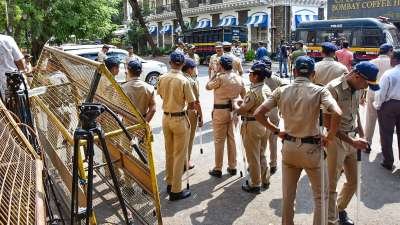Introduction
On Tuesday evening, a Mumbai-bound IndiGo flight from Chennai received a bomb threat message, causing significant concern and leading to immediate action by security agencies. The incident, which took place aboard IndiGo flight 6E 5149, highlights the ongoing challenges of ensuring air travel safety amid increasing threats.
The Incident Unfolds
The bomb threat message was received at the IndiGo call center in New Delhi, prompting swift action. The flight, which was en route to Mumbai, landed safely at the Chhatrapati Shivaji Maharaj International Airport around 10:30 PM. Following established protocols, the aircraft was directed to an isolation bay, a secure area designated for dealing with potential threats.
In an official statement, IndiGo confirmed the threat: “IndiGo flight 6E 5149, operating from Chennai to Mumbai, had received a bomb threat. Upon landing in Mumbai, the crew followed protocol, and the aircraft was taken to an isolation bay. Hence, All passengers have safely disembarked the aircraft. We are working with security agencies and post completion of all security checks, the aircraft will be positioned back in the terminal area.”
Passenger Safety and Protocol
The safety of the passengers was the top priority. All passengers were evacuated from the aircraft without incident. Security agencies, including bomb detection and disposal squads, were immediately mobilized to conduct thorough checks of the aircraft and surrounding areas. No explosives or suspicious items were found, confirming the threat to be a hoax.
Despite the false alarm, the incident caused significant disruption and anxiety among passengers and crew. It also highlighted the effectiveness of security protocols in handling such situations, ensuring minimal risk to human life.
Widespread Threats Across Mumbai
The bomb threat on the IndiGo flight was not an isolated incident. On the same day, the headquarters of the Brihanmumbai Municipal Corporation (BMC) in Mumbai received a similar bomb threat via email. According to police reports, the anonymous sender threatened to blow up the BMC headquarters. In response, the police conducted a comprehensive search of the building but found nothing suspicious.
This threat was part of a larger pattern of bomb threats received by various institutions across Mumbai in recent days. Hospitals, colleges, and other public buildings were targeted. However, A Powai-based hospital received an email claiming that bombs had been planted on its premises and in 50 other hospitals in the city. Similarly, a South Mumbai college received a threat email stating that explosives had been placed within the institute and at numerous other colleges.
A Nationwide Concern
The problem extends beyond Mumbai. Airports in several other cities, including Varanasi, Chennai, Patna, Nagpur, Jaipur, Vadodara, Coimbatore, and Jabalpur, received similar bomb threat emails. The messages, sent from the email address exhumedyou888@gmail.com, contained alarming content: “Hello, there are explosives hidden in the Airport. The bombs will soon explode. You will all die.”
Authorities suspect that an online group known as “KNR” might be behind these threats. This group had previously sent similar emails to several schools in the Delhi-NCR region on May 1. Despite extensive searches and heightened security measures, all these threats turned out to be hoaxes.
Cybersecurity and Investigations
Indian cybersecurity agencies are actively involved in investigating the origin of these threatening emails. The use of a virtual private network (VPN) by the perpetrators has complicated efforts to trace them. However, authorities are determined to identify and apprehend those responsible to prevent future incidents and ensure public safety.
The increased frequency of such hoax threats raises significant concerns. While none of the threats materialized, they have caused widespread panic, disrupted daily operations, and stretched security resources thin. Moreover Each incident demands a full-scale security response, including evacuations, searches, and coordination between various security agencies.
Recent Trends and Previous Incidents
The recent bomb threats are part of a troubling trend of similar incidents. On Monday, a Dubai-bound flight at the Indira Gandhi International (IGI) Airport in Delhi received a bomb threat via email. Therefore The plane was thoroughly searched, and no explosives were found. This incident followed a series of similar threats to airports in April, all of which turned out to be false alarms.
The recurrent nature of these threats suggests a deliberate attempt to create fear and disruption. While the immediate physical threat has been non-existent so far, the psychological impact on passengers, staff, and the general public is considerable.
Ensuring Public Safety
Authorities are taking these threats very seriously, despite their recurrent hoax nature. Security measures at airports and other critical infrastructure have been bolstered. Meanwhile, Agencies are working round the clock to investigate the threats, identify the culprits, and understand their motives.
Passengers are advised to remain vigilant and report any suspicious activity. While security agencies are equipped to handle such threats, public awareness and cooperation are crucial components of effective security.
Conclusion
The Mumbai Bomb threat incident underscores the importance of rigorous security protocols and the need for constant vigilance in the face of potential threats. While the specific threat to IndiGo flight 6E 5149 was a false alarm, it served as a reminder of the ongoing challenges faced by security agencies. The coordinated response by security personnel ensured passenger safety and highlighted the effectiveness of current procedures.
However, the broader pattern of threats across Mumbai and other cities indicates a need for enhanced cybersecurity measures and public awareness. As investigations continue, authorities remain committed to ensuring the safety and security of all citizens, emphasizing that any threat, real or hoax, will be met with a swift and comprehensive response.












